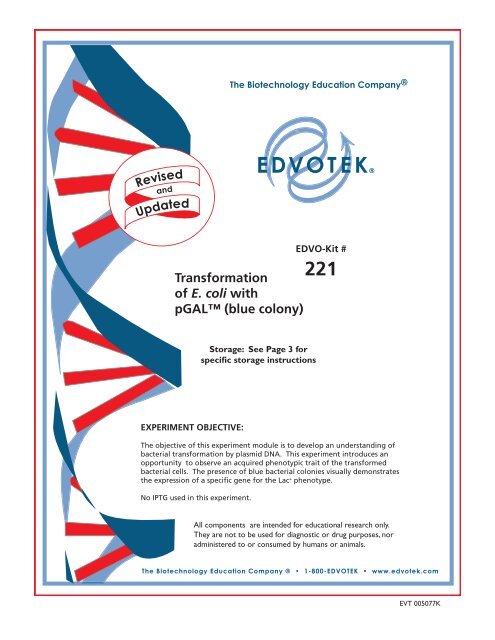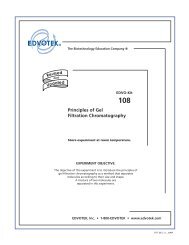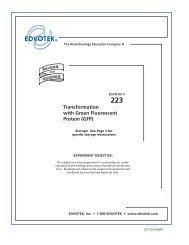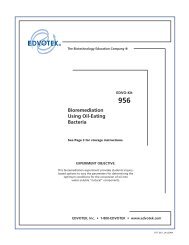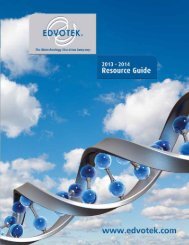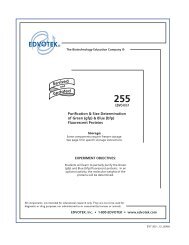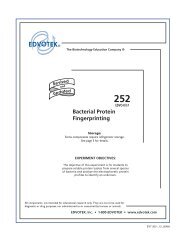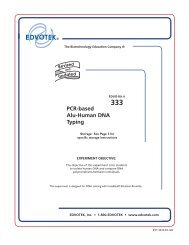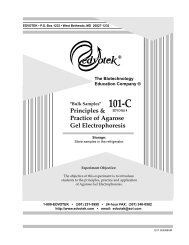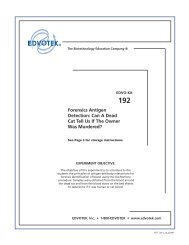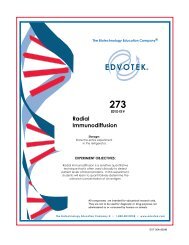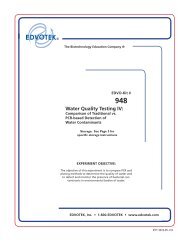221 Transformation of E. coli with pGAL⢠(blue colony) - EDVOTEK
221 Transformation of E. coli with pGAL⢠(blue colony) - EDVOTEK
221 Transformation of E. coli with pGAL⢠(blue colony) - EDVOTEK
- No tags were found...
You also want an ePaper? Increase the reach of your titles
YUMPU automatically turns print PDFs into web optimized ePapers that Google loves.
The Biotechnology Education Company ®RevisedandUpdated®<strong>Transformation</strong><strong>of</strong> E. <strong>coli</strong> <strong>with</strong>pGAL (<strong>blue</strong> <strong>colony</strong>)EDVO-Kit #<strong>221</strong>Storage: See Page 3 forspecific storage instructionsExperiment Objective:The objective <strong>of</strong> this experiment module is to develop an understanding <strong>of</strong>bacterial transformation by plasmid DNA. This experiment introduces anopportunity to observe an acquired phenotypic trait <strong>of</strong> the transformedbacterial cells. The presence <strong>of</strong> <strong>blue</strong> bacterial colonies visually demonstratesthe expression <strong>of</strong> a specific gene for the Lac + phenotype.No IPTG used in this experiment.All components are intended for educational research only.They are not to be used for diagnostic or drug purposes, noradministered to or consumed by humans or animals.The Biotechnology Education Company ® • 1-800-<strong>EDVOTEK</strong> • www.edvotek.comEVT 005077K
<strong>Transformation</strong> <strong>of</strong> E. <strong>coli</strong> <strong>with</strong> pGAL (<strong>blue</strong> <strong>colony</strong>)EDVO-Kit # <strong>221</strong>Important READ ME!<strong>Transformation</strong> experiments contain antibiotics which are used for the selection <strong>of</strong> transformedbacteria. Students who have allergies to antibiotics such as penicilllin, ampicillin,kanamycin or tetracycine should not participate in this experiment.Experiment ComponentsContentsComponentQuantities:Experiment # <strong>221</strong>is designed for 10groups (2-4 studentsper group).Storage: Store components A-G in the refrigerator.A <strong>Transformation</strong> LyphoCells (DO NOT FREEZE)B Supercoiled pGAL (<strong>blue</strong> <strong>colony</strong>)C Control Buffer (no DNA)D AmpicillinE X-Gal in solvent (pre-measured)**F Cell reconstitution mediumG Solvent for induction <strong>of</strong> competencyStorage: Store components listed below at Room temperature• Bottle ReadyPour Luria Broth Agar, sterile(also referred to as ReadyPour medium)• Bottle Luria Broth Medium for Recovery, sterile(also referred to as Luria Recovery Broth)• Petri plates• Plastic microtipped transfer pipets• inoculating loops (sterile)• Microtest tubes <strong>with</strong> attached lids** <strong>EDVOTEK</strong>'s solvent formulation <strong>of</strong>fers a safer alternative to the usualsolvent, N, N-dimethylformamide (DMF).All components are intended for educational research only.They are not to be used for diagnostic or drug purposes, noradministered to or consumed by humans or animals.None <strong>of</strong> the experiment components are derived from humansources.<strong>EDVOTEK</strong> - The Biotechnology Education Company ®1-800-<strong>EDVOTEK</strong> • www.edvotek.com24-hour FAX: (301) 340-0582 • email: edvotek@aol.comEVT 005077K
EDVO-Kit # <strong>221</strong><strong>Transformation</strong> <strong>of</strong> E. <strong>coli</strong> <strong>with</strong> pGAL (<strong>blue</strong> <strong>colony</strong>)Requirements• Automatic Micropipet (5-50 µl) and tips• Two Water baths (37°C and 42°C)• Thermometer• Incubation Oven (34°C and 37°C)• Pipet pumps or bulbs• Ice• Marking pens• Bunsen burner, hot plate or microwave oven• Hot gloves* If a second water bath is not available, water can be heated to 42°C ina beaker. The cells will require this temperature for only a few minutes.Alternatively, 42°C water can be put in a small styr<strong>of</strong>oam container <strong>with</strong> acover. The temperature needs to be held at 42°C.Online Orderingnow availableTechnical ServiceDepartmentVisit our web site for informationabout <strong>EDVOTEK</strong>'s completeline <strong>of</strong> experiments for biotechnologyand biology education.EDVO-TECH SERVICEMon - Fri9:00 am to 6:00 pm ETMon - Fri1-800-<strong>EDVOTEK</strong>(1-800-338-6835)9 am - 6 pm ETFAX: (301) 340-0582web: www.edvotek.comemail: edvotek@aol.comPlease have the following information:• The experiment number and title• Kit Lot number on box or tube• The literature version number(in lower right corner)• Approximate purchase dateEVT 005077KThe Biotechnology Education Company ® • 1-800-<strong>EDVOTEK</strong> • www.edvotek.com
<strong>Transformation</strong> <strong>of</strong> E. <strong>coli</strong> <strong>with</strong> pGAL (<strong>blue</strong> <strong>colony</strong>)EDVO-Kit # <strong>221</strong>Bacterial <strong>Transformation</strong>Bacterial transformation is <strong>of</strong> central importance in molecular biology.It allows for the introduction <strong>of</strong> genetically engineered or naturally occurringplasmids in bacterial cells. This makes possible the propagation,genetic expression and isolation <strong>of</strong> DNA plasmids.The transformation process involves the uptake <strong>of</strong> exogenous DNA bycells which results in a newly acquired genetic trait that is stable andheritable. Bacterial cells must be in a particular physiological statebefore they can be transformed. This state is referred to as competency.Competency can occur naturally in certain species <strong>of</strong> Haemophilus andBacillus when the levels <strong>of</strong> nutrients and oxygen are low. CompetentHaemophilus expresses a membrane associated transport complex whichbinds and transfers certain DNA molecules from the medium into thecell where they are incorporated and their genes are expressed. In nature,the source <strong>of</strong> external DNA is from other cells.Most <strong>of</strong> the current transformation experiments involve E. <strong>coli</strong>. This organismdoes not enter a stage <strong>of</strong> competency unless artificially induced.Treatment to achieve competency involves the use <strong>of</strong> chloride salts, suchas calcium chloride, and sudden hot and cold temperature changes. Themetal ions and temperature changes affect the structure and permeability<strong>of</strong> the cell wall and membrane so that DNA molecules can beabsorbed by the bacteria. The mechanism <strong>of</strong> DNA transport in the cellstill is not fully understood. Competent E. <strong>coli</strong> cells are fragile and mustbe treated carefully.Background InformationNumber <strong>of</strong>transformantsµg <strong>of</strong> DNA100transformants0.01 µgXSpecific example:Xfinal vol atrecovery (ml)vol plated (ml)1 ml0.1 mlFigure 1:Bacterial <strong>Transformation</strong> Efficiency Calculation==Number <strong>of</strong>transformantsper µg100,000(1 x 10 5 )transformantsper µgThe transformation efficiency is defined by the number <strong>of</strong> transformantsobtained per microgram <strong>of</strong> DNA. For example, 10 nanograms <strong>of</strong> DNAwere used for a transformation and the cells were allowed to recover ina final volume <strong>of</strong> 1 ml. One tenth <strong>of</strong> this volume was plated and produced100 colonies on a selective agarmedium. Therefore, 1000 transformantsare present per ml. Keeping inmind that each <strong>colony</strong> grew from onetransformed cell, the efficiency wouldbe 1000/0.01ug = 1 x 10 5 . <strong>Transformation</strong>efficiencies <strong>of</strong> 10 5 to 10 6 are morethan sufficient for most subcloningexperiments. When the cloning <strong>of</strong>single copy genes from genomic DNAis done, the required efficiencies are10 7 to 10 8 .The determination for transformationefficiency in this case is outlined in Figure1. <strong>Transformation</strong> efficiencies gen-Duplication <strong>of</strong> this document, in conjunction <strong>with</strong> use <strong>of</strong> accompanying reagents, is permitted for classroom/laboratoryuse only. This document, or any part, may not be reproduced or distributed for any other purpose <strong>with</strong>outthe written consent <strong>of</strong> <strong>EDVOTEK</strong>, Inc. Copyright © 1989, 90, 93, 94, 97, 98, 2000, 2005, <strong>EDVOTEK</strong>, Inc., all rightsreservedEVT 005077KThe Biotechnology Education Company ® • 1-800-<strong>EDVOTEK</strong> • www.edvotek.com
EDVO-Kit # <strong>221</strong><strong>Transformation</strong> <strong>of</strong> E. <strong>coli</strong> <strong>with</strong> pGAL (<strong>blue</strong> <strong>colony</strong>)Bacterial <strong>Transformation</strong>Background InformationPvu IIRru IPvu IMst IBgl IoriXmn Iamp rpGAL6751 bpEco RIBam HIEco RIHind IIIerally range from 1 x 10 4 to 1 x 10 7 cells per microgram <strong>of</strong> DNA. Thereare special procedures which can produce cells having transformationefficiencies approaching 10 10 . However, transformation is never 100%efficient. Approximately 1 in every 10,000 cells successfully incorporatesplasmid DNA in preparations having average competency. However,there is such a large number <strong>of</strong> cells in a sample (typically 1 x 10 9 ) thatonly a small fraction needs to be transformed to obtain colonies on aplate. The same volume <strong>of</strong> recovered cells plated on selective (containsantibiotic) and nonselective agar medium will yield vastly different numbers<strong>of</strong> cells. The nonselective medium will have many more growingcells that form a bcterial lawn.ß-GalactosidaseFigure 2 :DNA map <strong>of</strong> pGALNot all restriction enzymes are shown.Many different plasmids serve as useful tools inmolecular biology. One example is the pGALplasmid, present in multiple copies in specifiedhost E. <strong>coli</strong> host cells. It contains 6751 basepairs and has been cleverly modified by geneticengineering. In the cell, it does not integrateinto the bacterial chromosome, but replicatesautonomously. The pGAL plasmid contains theE. <strong>coli</strong> gene which codes for β-galactosidase. Inthe presence <strong>of</strong> artificial galactosides such as5-Bromo-4 Chloro 3-indolyl-β-D-galactoside (X-Gal), pGAL colonies appear <strong>blue</strong> when X-Gal iscleaved by β-galactosidase and forms a coloredproduct.This experiment has been designed to utilize<strong>EDVOTEK</strong> <strong>Transformation</strong> LyphoCells. It alsocontains the proprietary plasmid, pGAL (BlueColony), which was engineered by <strong>EDVOTEK</strong>.Plasmid pGAL carries the complete gene forβ‐galactosidase. Since the host E. <strong>coli</strong> does notcontain a β-galactosidase gene, only cells transformedby the pGAL plasmid will produce thefunctional β‐galactosidase enzyme. Cells thatexpress β-galactosidase will cleave X-Gal and thepGAL transformed colonies will be <strong>blue</strong>.Duplication <strong>of</strong> this document, in conjunction <strong>with</strong> use <strong>of</strong> accompanying reagents, is permitted for classroom/laboratoryuse only. This document, or any part, may not be reproduced or distributed for any other purpose <strong>with</strong>outthe written consent <strong>of</strong> <strong>EDVOTEK</strong>, Inc. Copyright © 1989, 90, 93, 94, 97, 98, 2000, 2005, <strong>EDVOTEK</strong>, Inc., all rightsreservedEVT 005077KThe Biotechnology Education Company ® • 1-800-<strong>EDVOTEK</strong> • www.edvotek.com
<strong>Transformation</strong> <strong>of</strong> E. <strong>coli</strong> <strong>with</strong> pGAL (<strong>blue</strong> <strong>colony</strong>)EDVO-Kit # <strong>221</strong>Bacterial <strong>Transformation</strong>In addition to the expression and cleavage <strong>of</strong> X-Gal by β-galactosidase,transformation by pGAL is also demonstrated by resistance to ampicillin.E. <strong>coli</strong> host cells used in this experiment are not naturally resistantto ampicillin. The plasmid pGAL contains the gene which encodes forβ-lactamase that inactivates ampicillin. E. <strong>coli</strong> cells transformed by pGALwill express the resistance gene product β-lactamase as an extracellularenzyme excreted from E. <strong>coli</strong> cells. Once outside the cell, the enzymediffuses into the surrounding medium and inactivates ampicillin.With time, small "satellite" colonies may appear around a large <strong>blue</strong> <strong>colony</strong>.Cells in the small "satellite" or "feeder" colonies are not resistantto ampicillin and have not been transformed <strong>with</strong> the pGAL plasmid.They are simply growing in a region <strong>of</strong> agar where β-lactamase has diffusedand inactivated the antibiotic ampicillin. The number <strong>of</strong> satellitecolonies increases if the concentration <strong>of</strong> ampicillin is low or the plateshave incubated for longer times.The ExperimentDuplication <strong>of</strong> this document, in conjunction <strong>with</strong> use <strong>of</strong> accompanying reagents, is permitted for classroom/laboratoryuse only. This document, or any part, may not be reproduced or distributed for any other purpose <strong>with</strong>outthe written consent <strong>of</strong> <strong>EDVOTEK</strong>, Inc. Copyright © 1989, 90, 93, 94, 97, 98, 2000, 2005, <strong>EDVOTEK</strong>, Inc., all rightsreservedEVT 005077KThe Biotechnology Education Company ® • 1-800-<strong>EDVOTEK</strong> • www.edvotek.com
EDVO-Kit # <strong>221</strong><strong>Transformation</strong> <strong>of</strong> E. <strong>coli</strong> <strong>with</strong> pGAL (<strong>blue</strong> <strong>colony</strong>)Experiment OverviewBefore you start the experiment1. Read all instructions before starting the experiment.The Experiment2. Write a hypothesis that reflects the experiment and predict experimentaloutcomes.Experiment Objective:The objective <strong>of</strong> this experiment module is to develop an understanding<strong>of</strong> the biologic process <strong>of</strong> bacterial transformation by plasmid DNA.This experiment demonstrates the acquired Lac + phenotypic trait <strong>of</strong> thetransformed bacterial cells as shown by the presence <strong>of</strong> <strong>blue</strong> bacterialcolonies.Brief Description <strong>of</strong> Experiment:In this experiment, students will transform host bacterial cells <strong>with</strong> aplasmid DNA. The transformants acquire antibiotic resistance and exhibita <strong>blue</strong> color due to the incorporation and expression <strong>of</strong> b-galactosidaseand ampicillin resistance genes. IPTG is not required since pGALcontains the intact b-galactosidase gene. The number <strong>of</strong> transformantswill be counted and the transformation efficiency will be determined.Duplication <strong>of</strong> this document, in conjunction <strong>with</strong> use <strong>of</strong> accompanying reagents, is permitted for classroom/laboratoryuse only. This document, or any part, may not be reproduced or distributed for any other purpose <strong>with</strong>outthe written consent <strong>of</strong> <strong>EDVOTEK</strong>, Inc. Copyright © 1989, 90, 93, 94, 97, 98, 2000, 2005, <strong>EDVOTEK</strong>, Inc., all rightsreservedEVT 005077KThe Biotechnology Education Company ® • 1-800-<strong>EDVOTEK</strong> • www.edvotek.com
<strong>Transformation</strong> <strong>of</strong> E. <strong>coli</strong> <strong>with</strong> pGAL (<strong>blue</strong> <strong>colony</strong>)EDVO-Kit # <strong>221</strong>Experiment Overview<strong>Transformation</strong> Experiment Flow Chart0.7 mlCells25 µlControl Buffer0.25 mlCells0.25 mlCells25 µlpGAL DNAThe ExperimentControlBufferIncubate on ice for10 minutesIncubate at 42°Cfor 90 secondsPlace on icefor 1 minuteAdd 0.75 ml recovery brothpGALDNAIncubate in 37°Cwater bath for 30 minutesFor optimal results, storecovered plates in the uprightposition after streakingto allow the cell suspensionto be absorbed by theagar. After approximately20 minutes, invert the platesfor overnight incubation at37°C.X-GAL/Control 1Incubateovernight in 37°Cincubation ovenAMP/X-GAL/Control 2Streak 0.25 ml <strong>of</strong> cellsuspension on platesIncubateovernight in 37°Cincubation ovenAMP/X-GAL/pGALX-GAL/Control 1AMP/X-GAL/Control 2AMP/X-GAL/pGALWhite Colonies No Colonies Blue ColoniesDuplication <strong>of</strong> this document, in conjunction <strong>with</strong> use <strong>of</strong> accompanying reagents, is permitted for classroom/laboratoryuse only. This document, or any part, may not be reproduced or distributed for any other purpose <strong>with</strong>outthe written consent <strong>of</strong> <strong>EDVOTEK</strong>, Inc. Copyright © 1989, 90, 93, 94, 97, 98, 2000, 2005, <strong>EDVOTEK</strong>, Inc., all rightsreservedEVT 005077KThe Biotechnology Education Company ® • 1-800-<strong>EDVOTEK</strong> • www.edvotek.com
10EDVO-Kit # <strong>221</strong><strong>Transformation</strong> <strong>of</strong> E. <strong>coli</strong> <strong>with</strong> pGAL (<strong>blue</strong> <strong>colony</strong>)Laboratory SafetyImportant READ ME!The Experiment<strong>Transformation</strong> experiments contain antibiotics which are used for theselection <strong>of</strong> transformed bacteria. Students who have allergies to antibioticssuch as penicilllin, ampicillin, kanamycin or tetracycine shouldnot participate in this experiment.1. Gloves and goggles should be worn routinely as good laboratorypractice.2. Exercise extreme caution when working <strong>with</strong> equipment which isused in conjunction <strong>with</strong> the heating and/or melting <strong>of</strong> reagents.3. Do not mouth pipet reagents - use pipet pumps or bulbs.4. The E. <strong>coli</strong> bacteria used in this experiment is not considered pathogenic.Although it is rarely associated <strong>with</strong> any illness in healthyindividuals, it is good practice to follow simple safety guidelines inhandling and disposal <strong>of</strong> materials contaminated <strong>with</strong> bacteria.5. Properly dispose materials after completing the experiment:A. Wipe down the lab bench <strong>with</strong> a 10% bleach solution or a laboratorydisinfectant.B. All materials, including petri plates, pipets, transfer pipets,loops and tubes, that come in contact <strong>with</strong> bacteria should bedisinfected before disposal in the garbage. Disinfect materialsas soon as possible after use in one <strong>of</strong> the following ways:• Autoclave at 121° C for 20 minutes.Tape several petri plates together and close tube caps beforedisposal. Collect all contaminated materials in an autoclavable,disposable bag. Seal the bag and place it in a metal tray to preventany possibility <strong>of</strong> liquid medium or agar from spilling intothe sterilizer chamber.• Soak in 10% bleach solution.Immerse petri plates, open tubes and other contaminated materialsinto a tub containing a 10% bleach solution. Soak the materialsovernight and then discard. Wear gloves and goggleswhen working <strong>with</strong> bleach.6. Wear gloves, and at the end <strong>of</strong> the experiment, wash hands thoroughly<strong>with</strong> soap and water.Duplication <strong>of</strong> this document, in conjunction <strong>with</strong> use <strong>of</strong> accompanying reagents, is permitted for classroom/laboratoryuse only. This document, or any part, may not be reproduced or distributed for any other purpose <strong>with</strong>outthe written consent <strong>of</strong> <strong>EDVOTEK</strong>, Inc. Copyright © 1989, 90, 93, 94, 97, 98, 2000, 2005, <strong>EDVOTEK</strong>, Inc., all rightsreservedEVT 005077KThe Biotechnology Education Company ® • 1-800-<strong>EDVOTEK</strong> • www.edvotek.com
<strong>Transformation</strong> <strong>of</strong> E. <strong>coli</strong> <strong>with</strong> pGAL (<strong>blue</strong> <strong>colony</strong>) EDVO-Kit # <strong>221</strong> 11<strong>Transformation</strong> <strong>of</strong> E.<strong>coli</strong>Setting up the <strong>Transformation</strong> andControl Experiment1. Put your initials or group number on thetubes labeled “pGAL DNA” (contains 25 µl<strong>of</strong> plasmid DNA) and “Control Buffer” (contains25 µl <strong>of</strong> buffer) . Place them back on ice.2. Set up the Control:• Using a sterile transfer pipet, transfer0.25 ml (250 µl) <strong>of</strong> cell suspensionfrom the tube “Cells” to thetube “Control Buffer”.• Carefully place the pipet back intothe wrapper.• Cap the tube; mix by tapping. Putthe tube back on ice.ControlBufferpGALDNApGALDNAControlBufferThe Experiment1 ml3. Set up the transformation:• Using the same pipet from Step 2, transfer 0.25 ml(250 µl) <strong>of</strong> cell suspension from the tube “Cells” tothe tube “pGAL DNA”.• Cap the tube; mix by tapping. Put the tubeback on ice.0.5 ml4. Incubate the cells prepared in steps 1 - 3 on icefor 10 minutes.- DNA+ DNA0.25 ml~ 0.06 ml5. Place both transformation tubes at 42°C for90 seconds.< 0.02 mlThis heat shock step facilitates the entry <strong>of</strong>DNA in bacterial cells.Guide for SterileCalibratedTransfer Pipet6. Return both tubes to the ice bucket andincubate for for 1 minute.- DNA+ DNA- DNA+ DNADuplication <strong>of</strong> this document, in conjunction <strong>with</strong> use <strong>of</strong> accompanying reagents, is permitted for classroom/laboratoryuse only. This document, or any part, may not be reproduced or distributed for any other purpose <strong>with</strong>outthe written consent <strong>of</strong> <strong>EDVOTEK</strong>, Inc. Copyright © 1989, 90, 93, 94, 97, 98, 2000, 2005, <strong>EDVOTEK</strong>, Inc., all rightsreservedEVT 005077KThe Biotechnology Education Company ® • 1-800-<strong>EDVOTEK</strong> • www.edvotek.com
12EDVO-Kit # <strong>221</strong><strong>Transformation</strong> <strong>of</strong> E. <strong>coli</strong> <strong>with</strong> pGAL (<strong>blue</strong> <strong>colony</strong>)<strong>Transformation</strong> <strong>of</strong> E.<strong>coli</strong>7. Add 0.75 ml <strong>of</strong> the Recovery Broth tothe tube “Control Buffer”.The ExperimentQuick Reference:Add the recovery broth <strong>with</strong> a sterile1 ml pipet. Avoid touching thecells <strong>with</strong> the pipet.8. Add 0.75 ml <strong>of</strong> the Recovery Brothto the tube “pGAL DNA”.DNA and competent cells are combined in a 0.25 ml suspension. After thecells have incubated <strong>with</strong> the DNA, growth medium (recovery broth) isadded. Bacterial cells continue to grow through the recovery process, duringwhich time the cell wall is repaired. Cells recover and begin to expressthe antibiotic resistance gene.- DNAControlBufferpGALDNA+ DNA9. Incubate the closed tubes in a 37°C waterbath for 30 minutes for a recovery period.10. While the tubes are incubating, label 3agar plates as indicated below. Write on the bottom or side <strong>of</strong> thepetri plate.• Label one unstriped plate: X-GAL/Control 1• Label one striped plate: AMP/X-GAL/Control 2• Label one striped plate: AMP/X-GAL/pGAL• Put your initials or group number on all the plates.11. After the recovery period, remove the tubesfrom the water bath and place them on thelab bench. Proceed to plating the cells forControlBufferpGALDNADuplication <strong>of</strong> this document, in conjunction <strong>with</strong> use <strong>of</strong> accompanying reagents, is permitted for classroom/laboratoryuse only. This document, or any part, may not be reproduced or distributed for any other purpose <strong>with</strong>outthe written consent <strong>of</strong> <strong>EDVOTEK</strong>, Inc. Copyright © 1989, 90, 93, 94, 97, 98, 2000, 2005, <strong>EDVOTEK</strong>, Inc., all rightsreservedEVT 005077KThe Biotechnology Education Company ® • 1-800-<strong>EDVOTEK</strong> • www.edvotek.com
<strong>Transformation</strong> <strong>of</strong> E. <strong>coli</strong> <strong>with</strong> pGAL (<strong>blue</strong> <strong>colony</strong>) EDVO-Kit # <strong>221</strong> 13<strong>Transformation</strong> <strong>of</strong> E.<strong>coli</strong>Plating the cellsPlating cells from the tube labeled "Control":12. Use a fresh, sterile 1 ml pipet to transfer recovered cells from thetube "Control Buffer" to the middle <strong>of</strong> the following plates:• 0.25 ml to the plate labeled X-GAL/Control 1• 0.25 ml to the plate labeled AMP/XGAL/Control 213. Spread the cells over the entireplate <strong>with</strong> a sterile inoculatingloop.14. Cover both control plates and allowthe liquid to be absorbed.The ExperimentSpread cells inone directionSame plate -spread cells 90°to first directionTo avoid contamination when plating, do notset the lid down on the lab bench -- Lift thelid <strong>of</strong> the plate only enough to allow spreading.Be careful to avoid gouging the loopinto the agar.Plating cells from the tube labeled "pGAL DNA"15. Use a fresh, sterile 1 ml pipet to transfer recovered cells from thetube "pGAL DNA" to the middle <strong>of</strong> the following plate:• 0.25 ml to the plate labeled AMP/X-GAL/pGAL16. Spread the cells <strong>with</strong> a sterile inoculating loop.Reminder:Follow properproceduresfor disposal <strong>of</strong>contaminatedmaterials.17. Cover the plate and allow the liquid to be absorbed (approximately15-20 minutes).Duplication <strong>of</strong> this document, in conjunction <strong>with</strong> use <strong>of</strong> accompanying reagents, is permitted for classroom/laboratoryuse only. This document, or any part, may not be reproduced or distributed for any other purpose <strong>with</strong>outthe written consent <strong>of</strong> <strong>EDVOTEK</strong>, Inc. Copyright © 1989, 90, 93, 94, 97, 98, 2000, 2005, <strong>EDVOTEK</strong>, Inc., all rightsreservedEVT 005077KThe Biotechnology Education Company ® • 1-800-<strong>EDVOTEK</strong> • www.edvotek.com
14EDVO-Kit # <strong>221</strong><strong>Transformation</strong> <strong>of</strong> E. <strong>coli</strong> <strong>with</strong> pGAL (<strong>blue</strong> <strong>colony</strong>)<strong>Transformation</strong> <strong>of</strong> E.<strong>coli</strong>Preparing Plates for Incubation20. Stack your group's set <strong>of</strong> plates on top <strong>of</strong> one another and tapethem together. Put your initials or group number on the taped set<strong>of</strong> plates.The ExperimentReminder:Follow properproceduresfor disposal <strong>of</strong>contaminatedmaterials.The plates should be left in the upright position to allow the cell suspensionto be absorbed by the agar.21. Place the set <strong>of</strong> plates in a safe place designated by your instructor.22. After the cell suspension is absorbed by the agar(approximately 15 -20 minutes), you or yourinstructor will place the plates in the invertedposition (agar side on top) in a 37°C bacterialincubation oven for overnight incubation (15-20hours).If the cells have not been absorbed into the medium,it is best to incubate the plates upright. Theplates are inverted to prevent condensation onthe lid, which could drip onto the culture and mayinterfere <strong>with</strong> experimental results.Group 4Viewing Plates After Incubation23. Proceed to analyzing your results.24. After analyzing your results, follow proper procedures for disposal<strong>of</strong> contaminated materials.Duplication <strong>of</strong> this document, in conjunction <strong>with</strong> use <strong>of</strong> accompanying reagents, is permitted for classroom/laboratoryuse only. This document, or any part, may not be reproduced or distributed for any other purpose <strong>with</strong>outthe written consent <strong>of</strong> <strong>EDVOTEK</strong>, Inc. Copyright © 1989, 90, 93, 94, 97, 98, 2000, 2005, <strong>EDVOTEK</strong>, Inc., all rightsreservedEVT 005077KThe Biotechnology Education Company ® • 1-800-<strong>EDVOTEK</strong> • www.edvotek.com
<strong>Transformation</strong> <strong>of</strong> E. <strong>coli</strong> <strong>with</strong> pGAL (<strong>blue</strong> <strong>colony</strong>) EDVO-Kit # <strong>221</strong> 15Experiment Results and AnalysisLaboratory notebook recordings:Address and record the following in your laboratory notebook or on aseparate worksheet.Before starting the Experiment:• Write a hypothesis that reflects the experiment.• Predict experimental outcomes.During the Experiment:• Record (draw) your observations, or photograph the results.Following the Experiment:The Experiment• Formulate an explanation from the results.• Determine what could be changed in the experiment if theexperiment were repeated.• Write a hypothesis that would reflect this change.Answer these questions BEFORE analyzing yourresults.1. On which plate(s) would you find only genetically transformed bacterialcells? Explain.2. What is the purpose <strong>of</strong> the control plates? Explain the differencebetween each and why it is necessary to run each.3. Why would one compare plates AMP/X-GAL and AMP/X-GAL/pGAL?ContinuedDuplication <strong>of</strong> this document, in conjunction <strong>with</strong> use <strong>of</strong> accompanying reagents, is permitted for classroom/laboratoryuse only. This document, or any part, may not be reproduced or distributed for any other purpose <strong>with</strong>outthe written consent <strong>of</strong> <strong>EDVOTEK</strong>, Inc. Copyright © 1989, 90, 93, 94, 97, 98, 2000, 2005, <strong>EDVOTEK</strong>, Inc., all rightsreservedEVT 005077KThe Biotechnology Education Company ® • 1-800-<strong>EDVOTEK</strong> • www.edvotek.com
<strong>Transformation</strong> <strong>of</strong> E. <strong>coli</strong> <strong>with</strong> pGAL (<strong>blue</strong> <strong>colony</strong>) EDVO-Kit # <strong>221</strong> 17Experiment Results and AnalysisDetermination <strong>of</strong> <strong>Transformation</strong> Efficiency<strong>Transformation</strong> efficiency is a quantitative determination <strong>of</strong> how manycells were transformed per 1 µg <strong>of</strong> plasmid DNA. In essence, it is an indicator<strong>of</strong> how well the transformation experiment worked.You will calculate the transformation efficiency from the data you collectfrom your experiment.1. Count the number <strong>of</strong> colonies on the plate <strong>with</strong> ampicillin that islabeled:AMP/X-GAL/pGALA convenient method to keep track <strong>of</strong> counted colonies is to markthe <strong>colony</strong> <strong>with</strong> a lab marking pen on the outside <strong>of</strong> the plate.The Experiment2. Determine the transformation efficiency using the formula:Number <strong>of</strong>transformantsµg <strong>of</strong> DNAfinal vol atrecovery (ml)x =vol plated (ml)Number <strong>of</strong>transformantsper µgExample:Assume you observed 40 colonies:40transformants0.025 µgx1.0 ml0.25 ml=6400(6.4 x 10 3 )transformantsper µgQuick Reference for Expt. <strong>221</strong>25 ng (0.025 µg) <strong>of</strong> DNA is used.The final volume at recovery is 1.0 ml.The volume plated is0.25 ml.Duplication <strong>of</strong> this document, in conjunction <strong>with</strong> use <strong>of</strong> accompanying reagents, is permitted for classroom/laboratoryuse only. This document, or any part, may not be reproduced or distributed for any other purpose <strong>with</strong>outthe written consent <strong>of</strong> <strong>EDVOTEK</strong>, Inc. Copyright © 1989, 90, 93, 94, 97, 98, 2000, 2005, <strong>EDVOTEK</strong>, Inc., all rightsreservedEVT 005077KThe Biotechnology Education Company ® • 1-800-<strong>EDVOTEK</strong> • www.edvotek.com
18EDVO-Kit # <strong>221</strong><strong>Transformation</strong> <strong>of</strong> E. <strong>coli</strong> <strong>with</strong> pGAL (<strong>blue</strong> <strong>colony</strong>)Study QuestionsAnswer the following study questions in your laboratory notebook or ona separate worksheet.The Experiment1. Did you observe any satellite colonies? Why are the satellite, feedercolonies white?2. Why did the competent cells which did not receive DNA (control)fail to grow on the plates containing ampicillin?3. Why are there so many cells growing on the X-GAL plate? Whatcolor are they?4. What evidence do you have that transformation was successful?5. What are some reasons why transformation may be unsuccessful?Duplication <strong>of</strong> this document, in conjunction <strong>with</strong> use <strong>of</strong> accompanying reagents, is permitted for classroom/laboratoryuse only. This document, or any part, may not be reproduced or distributed for any other purpose <strong>with</strong>outthe written consent <strong>of</strong> <strong>EDVOTEK</strong>, Inc. Copyright © 1989, 90, 93, 94, 97, 98, 2000, 2005, <strong>EDVOTEK</strong>, Inc., all rightsreservedEVT 005077KThe Biotechnology Education Company ® • 1-800-<strong>EDVOTEK</strong> • www.edvotek.com
<strong>Transformation</strong> <strong>of</strong> E. <strong>coli</strong> <strong>with</strong> pGAL (<strong>blue</strong> <strong>colony</strong>) EDVO-Kit # <strong>221</strong> 19Instructor’s GuideNotes to the Instructor:Online Orderingnow availableVisit our web site forinformation about<strong>EDVOTEK</strong>'s completeline <strong>of</strong> experiments forbiotechnology andbiology education.EDVO-TECH SERVICEMon - Fri1-800-<strong>EDVOTEK</strong>(1-800-338-6835)9 am - 6 pm ETImportant READ ME!<strong>Transformation</strong> experiments contain antibiotics which are used for theselection <strong>of</strong> transformed bacteria. Students who have allergies to antibioticssuch as penicilllin, ampicillin, kanamycin or tetracycine shouldnot participate in this experiment.Organizing and Implementing the ExperimentClass size, length <strong>of</strong> laboratory sessions, and availability <strong>of</strong> equipmentare factors which must be considered in the planning and the implementation<strong>of</strong> this experiment <strong>with</strong> your students.The guidelines that are presented in this manual are based on ten laboratorygroups consisting <strong>of</strong> two, or up to four students. The followingare implementation guidelines, which can be adapted to fit your specificset <strong>of</strong> circumstances. If you do not find the answers to your questionsin this section, a variety <strong>of</strong> resources are available at the <strong>EDVOTEK</strong> website. In addition, Technical Service is available from 9:00 am to 6:00 pm,Eastern time zone. Call 1-800-<strong>EDVOTEK</strong> for help from our knowledgeabletechnical staff.Technical ServiceDepartmentMon - Fri9:00 am to 6:00 pm ETFAX: (301) 340-0582web: www.edvotek.comemail: edvotek@aol.comPlease have the following information:• The experiment number and title• Kit Lot number on box or tube• The literature version number(in lower right corner)• Approximate purchase dateDay 1: (Prior to the Lab)• Prepare agar plates• Prepare LyphoCells (overnight incubation).• Dispense the DNA and control bufferDay 2: (Day <strong>of</strong> Lab Experiment)• Equilibrate water baths at 37°C and42°C; incubation oven at 37°C• Students transform cells and plate forovernight incubation.Day 3: (Day after Lab Experiment)• Students observe transformants andcontrols• Students calculate transformation efficiency• Follow clean up and disposal proceduresas outlined in the Laboratory Safety section.<strong>EDVOTEK</strong> - The Biotechnology Education Company ®1-800-<strong>EDVOTEK</strong> • www.edvotek.com24-hour FAX: (301) 340-0582 • email: edvotek@aol.comEVT 005077K
20EDVO-Kit # <strong>221</strong><strong>Transformation</strong> <strong>of</strong> E. <strong>coli</strong> <strong>with</strong> pGAL (<strong>blue</strong> <strong>colony</strong>)Notes to the Instructor:National content and skill standardsInstructor’s GuideBy performing this experiment, students will develop skills necessary todo scientific inquiry, learn new techniques using several types <strong>of</strong> biotechnologyequipment, and will learn standard procedures used in transformation.Analysis <strong>of</strong> the experiments will provide students the means totransform an abstract concept into a concrete explanation.APPROXIMATE TIME REQUIREMENTS1. The experiment requires the reconstitution and incubation <strong>of</strong> LyphoCellsat 34-37°C for 16-24 hours before the laboratory (overnightincubation). Plan accordingly. For optimal results, incubateLyphoCells at 34-37°C for 19 hours.2. The agar plates can be prepared several days in advance and storedinverted (agar side on top) in the refrigerator. Preparation requiresapproximately 1 hour.LABORATORYNOTEBOOKSIt is highly recommendedthat students maintain alaboratory notebook t<strong>of</strong>ormulate hypotheses andto record experimentalprocedures and results.• <strong>EDVOTEK</strong> Cat. # 1401,Laboratory DataBookis recommended.• Guidelines for keepinga laboratory notebookis available at the<strong>EDVOTEK</strong> web site.3. Dispensing the DNA and control buffer requires approximately 30minutes. This can be done the day before the lab and stored in therefrigerator.4. Competent cells must be dispensed just prior to the lab experiment.If tubes are already labeled, dispensing will require approximately15 minutes.5. Allow ample time for the equilibration <strong>of</strong> the water baths at37°C and 42°C and a bacterial incubation oven at 37°C on theday <strong>of</strong> the experiment.6. Each group will perform the transformation experiment andplate a set <strong>of</strong> three bacterial cells. These procedures requireapproximately 50 minutes.7. Overnight incubation <strong>of</strong> plates is approximately 15-20 hours at37°C Colonies will also appear between 24 - 48 hours at roomtemperature.8. Follow disposal procedures as outlined in the section regardingLaboratory Safety.Duplication <strong>of</strong> this document, in conjunction <strong>with</strong> use <strong>of</strong> accompanying reagents, is permitted for classroom/laboratoryuse only. This document, or any part, may not be reproduced or distributed for any other purpose <strong>with</strong>outthe written consent <strong>of</strong> <strong>EDVOTEK</strong>, Inc. Copyright © 1989, 90, 93, 94, 97, 98, 2000, 2005, <strong>EDVOTEK</strong>, Inc., all rightsreservedEVT 005077KThe Biotechnology Education Company ® • 1-800-<strong>EDVOTEK</strong> • www.edvotek.com
<strong>Transformation</strong> <strong>of</strong> E. <strong>coli</strong> <strong>with</strong> pGAL (<strong>blue</strong> <strong>colony</strong>) EDVO-Kit # <strong>221</strong> 21Pre-Lab PreparationsPour Agar Plates(Prior to the Lab experiment)Wear Hot Glovesand Goggles during allsteps involving heating.• For optimal results, prepare plates two days prior to plating and setaside the plates inverted at room temperature.• If they are poured more than two days before use, they should bestored inverted in the refrigerator. Remove the plates from therefrigerator and store inverted for two days at room temperaturebefore use.Heat the ReadyPour Medium1. Equilibrate a water bath at 60°C for step 5 below.2. Loosen, but do not remove, the cap on the ReadyPour mediumbottle to allow for the venting <strong>of</strong> steam during heating.Instructor’s GuideCaution: Failure to loosen the cap prior to heating or microwavingmay cause the ReadyPour medium bottle to break or explode.3. Squeeze and vigorously shake the plastic bottle to break up thesolid agar into chunks4. Heat the bottle <strong>of</strong> ReadyPour medium by one <strong>of</strong> the methods outlinedbelow. When completely melted, the amber-colored solutionshould appear free <strong>of</strong> small particles.A. Microwave method:• Heat the bottle on High for two 30 second intervals.• Using a hot glove, swirl and heat on High for an additional25 seconds, or until all the medium is dissolved.• Using a hot glove, occasionally swirl to expedite melting.B. Hot plate or burner method:• Place the bottle in a beaker partially filled <strong>with</strong> water.• Heat the beaker to boiling over a hot plate or burner.• Using a hot glove, occasionally swirl to expedite melting.5. Allow the melted ReadyPour medium to cool. Placing the bottle ina 60°C water bath will allow the agar to cool, whilepreventing it from prematurely solidifying.When the ReadyPour medium reaches approximately60°C, the bottle will be warm to the touch but not burninghot.60˚CDuplication <strong>of</strong> this document, in conjunction <strong>with</strong> use <strong>of</strong> accompanying reagents, is permitted for classroom/laboratoryuse only. This document, or any part, may not be reproduced or distributed for any other purpose <strong>with</strong>outthe written consent <strong>of</strong> <strong>EDVOTEK</strong>, Inc. Copyright © 1989, 90, 93, 94, 97, 98, 2000, 2005, <strong>EDVOTEK</strong>, Inc., all rightsreservedEVT 005077KThe Biotechnology Education Company ® • 1-800-<strong>EDVOTEK</strong> • www.edvotek.com
22EDVO-Kit # <strong>221</strong><strong>Transformation</strong> <strong>of</strong> E. <strong>coli</strong> <strong>with</strong> pGAL (<strong>blue</strong> <strong>colony</strong>)Pre-Lab PreparationsLabel (“Stripe”) the Plates6. Use a lab marker to "stripe" the sides <strong>of</strong> twenty (20) 60 x15 mmpetri dishes. This will provide an easy method <strong>of</strong> differentiatingbetween plates <strong>with</strong> ampicillin and plates <strong>with</strong>out ampicillin.Instructor’s Guide• Open one sleeve <strong>of</strong> 20 plates and stack the plates neatly.• Start the marker at the bottom <strong>of</strong> the stack and move themarker vertically to the top plate to "stripe" the sides <strong>of</strong> the 20plates.• These plates will be used for medium <strong>with</strong> ampicillin.• Do not stripe the second sleeve <strong>of</strong> plates. These will be thecontrol plates.Pour the Plates (after the medium has cooled)7 . Thaw and add all <strong>of</strong> the X-Gal solution (Component E) to the moltenand cooled ReadyPour medium. Recap bottle and swirl to mix.Add reagents to mediumwhich has beencooled. Hot mediumwill cause reagentssuch as ampicillin torapidly decompose.8. Use a fresh 10 ml pipet and pipet pump to pour 10 unstriped plates,5 ml each. (See Quick Reference: Pouring Agar Plates.) Save thepipet for step 11.Quick Reference: Pouring Agar Plates• Use a sterile 10 ml pipet <strong>with</strong> a pipet pump to transfer thedesignated volume <strong>of</strong> medium to each petri plate. Pipet carefullyto avoid forming bubbles.• Rock the petri plate back and forth to obtain full coverage.• If the molten medium contains bubbles, they can be removed bypassing a flame across the surface <strong>of</strong> the medium.• Cover the petri plate and allow the medium to solidify.Duplication <strong>of</strong> this document, in conjunction <strong>with</strong> use <strong>of</strong> accompanying reagents, is permitted for classroom/laboratoryuse only. This document, or any part, may not be reproduced or distributed for any other purpose <strong>with</strong>outthe written consent <strong>of</strong> <strong>EDVOTEK</strong>, Inc. Copyright © 1989, 90, 93, 94, 97, 98, 2000, 2005, <strong>EDVOTEK</strong>, Inc., all rightsreservedEVT 005077KThe Biotechnology Education Company ® • 1-800-<strong>EDVOTEK</strong> • www.edvotek.com
<strong>Transformation</strong> <strong>of</strong> E. <strong>coli</strong> <strong>with</strong> pGAL (<strong>blue</strong> <strong>colony</strong>) EDVO-Kit # <strong>221</strong> 23Pre-Lab Preparations9. Add the ampicillin powder (entire contents <strong>of</strong> tube D) to the remainingmolten ReadyPour medium.10. Recap the bottle; swirl to completely dissolve the ampicillin powder.Reminder:Follow properproceduresfor disposal <strong>of</strong>contaminatedmaterials.11. Use the pipet from step 8 to pour 20 striped plates, 5 ml each. Pourextra plates <strong>with</strong> any remaining medium.12. Allow the agar to cool and resolidify.Note: If plates will be used <strong>with</strong>in two days, store in a sealable plasticbag so the plates will not dry out. Store at room temperature, inverted.Summary <strong>of</strong> Poured Plates:Instructor’s Guide10 Agar plates <strong>with</strong> X-GALno stripe plates: 5 ml each - ReadyPourmedium <strong>with</strong>out ampicillin20 Agar plates <strong>with</strong> X-GAL and AMPstriped plates: 5 ml each - ReadyPourmedium <strong>with</strong> ampicillinDuplication <strong>of</strong> this document, in conjunction <strong>with</strong> use <strong>of</strong> accompanying reagents, is permitted for classroom/laboratoryuse only. This document, or any part, may not be reproduced or distributed for any other purpose <strong>with</strong>outthe written consent <strong>of</strong> <strong>EDVOTEK</strong>, Inc. Copyright © 1989, 90, 93, 94, 97, 98, 2000, 2005, <strong>EDVOTEK</strong>, Inc., all rightsreservedEVT 005077KThe Biotechnology Education Company ® • 1-800-<strong>EDVOTEK</strong> • www.edvotek.com
24EDVO-Kit # <strong>221</strong><strong>Transformation</strong> <strong>of</strong> E. <strong>coli</strong> <strong>with</strong> pGAL (<strong>blue</strong> <strong>colony</strong>)Pre-Lab PreparationsPreparation <strong>of</strong> Competent CellsDay before the LabInstructor’s Guide1. Use a 10 ml sterile pipet to add 6 ml sterile cell reconstitution medium(Component F) to the vial <strong>of</strong> LyphoCells.2. Replace the rubber stopper and cap. Mix by inverting until thefreeze dried plug is dissolved.3. Shake the cell suspension vigorously and incubate the vial at 34-37°Cfor 16 - 24 hours (overnight) in an incubation oven. For optimalresults, incubate LyphoCells for 19 hours.Day <strong>of</strong> the Lab4. Completely thaw the competency induction solvent (G) and place onice. (If there is a white precipitate in the bottle, warm it in a 37°Cwaterbath to dissolve the precipitate.)5. Mix and resuspend the vial <strong>of</strong> incubated cells by inverting and gentlyshaking. Place the vial on ice for 10 minutes.6. Use a 10 ml sterile pipet to add 3 ml <strong>of</strong> ice cold competency inductionsolvent (G) to the vial <strong>of</strong> cells.The competency induction solvent is very viscous. Make sure that aportion <strong>of</strong> the solvent is not left on the walls <strong>of</strong> the pipet.7. Mix the cells and induction solvent thoroughly by inverting the vialseveral times. The solution should have no dense layers, "streams"or globules (i.e. it should be a uniform suspension).8. Keep the cells on ice for a minimum <strong>of</strong> 30 minutes.Cells can be kept on ice for up to 3 hours.Duplication <strong>of</strong> this document, in conjunction <strong>with</strong> use <strong>of</strong> accompanying reagents, is permitted for classroom/laboratoryuse only. This document, or any part, may not be reproduced or distributed for any other purpose <strong>with</strong>outthe written consent <strong>of</strong> <strong>EDVOTEK</strong>, Inc. Copyright © 1989, 90, 93, 94, 97, 98, 2000, 2005, <strong>EDVOTEK</strong>, Inc., all rightsreservedEVT 005077KThe Biotechnology Education Company ® • 1-800-<strong>EDVOTEK</strong> • www.edvotek.com
<strong>Transformation</strong> <strong>of</strong> E. <strong>coli</strong> <strong>with</strong> pGAL (<strong>blue</strong> <strong>colony</strong>) EDVO-Kit # <strong>221</strong> 25Pre-Lab PreparationsDispensing the Cells just prior to the ExperimentKeep cells on iceduring dispensingprocedures.11. Mix the cells by inversion to obtain an even suspension.12. Use a sterile 1 ml pipet to aliquot 0.7 ml <strong>of</strong> cells to 10 ice cold tubeslabeled "Cells"13. Cap the tubes and keep them on ice.Preparation <strong>of</strong> DNA and Control Buffer1. Place the tubes <strong>of</strong> supercoiled pGAL DNA (Component B) and controlbuffer (Component C) on ice.2. Before dispensing DNA and Control buffer, tap the tubes until allthe sample is at the tapered bottom <strong>of</strong> the tube.Instructor’s GuideSummary <strong>of</strong> Reagent PreparationsDispense10 plates Agar plates <strong>with</strong>X-GAL (No Stripe) 5 ml20 plates Agar plates <strong>with</strong> AMPand X-GAL (Striped) 5 ml10 tubes pGAL DNA 25 µl on ice10 tubes Control Buffer 25 µl on ice10 tubes Cells 0.7 ml on iceEach Group Requires:1 tube pGAL DNA 25 µl on ice1 tube Cells 0.7 ml on ice1 tube Control Buffer 25 µl on ice1 agar plate - no stripe2 agar plates - striped4 sterile 1 ml pipets2 sterile inoculating loops1 tube Recovery broth (optional) 1.5 ml2 micropipet tips (if using automatic micropipets)3. Using an automatic micropipet,dispense 25 µl <strong>of</strong> the supercoiledpGAL DNA to each <strong>of</strong>the 10 microtest tubes labeled"pGAL DNA".4. Cap the tubes and place themon ice.5. Using a FRESH micropipet tip,dispense 25 µl <strong>of</strong> control bufferto each <strong>of</strong> 10 microtest tubeslabeled "Control Buffer".6. Cap the tubes and place themon ice.Recovery Broth (Optional)Set up a classroom pipeting station, ordispense recovery broth (optional).7. Dispense 1.5 ml Recovery Broth into 10sterile tubes labeled "Recovery Broth"using a sterile pipet.8. Cap the tubes and place them in therefrigerator if not to be used immediately.Duplication <strong>of</strong> this document, in conjunction <strong>with</strong> use <strong>of</strong> accompanying reagents, is permitted for classroom/laboratoryuse only. This document, or any part, may not be reproduced or distributed for any other purpose <strong>with</strong>outthe written consent <strong>of</strong> <strong>EDVOTEK</strong>, Inc. Copyright © 1989, 90, 93, 94, 97, 98, 2000, 2005, <strong>EDVOTEK</strong>, Inc., all rightsreservedEVT 005077KThe Biotechnology Education Company ® • 1-800-<strong>EDVOTEK</strong> • www.edvotek.com
26EDVO-Kit # <strong>221</strong><strong>Transformation</strong> <strong>of</strong> E. <strong>coli</strong> <strong>with</strong> pGAL (<strong>blue</strong> <strong>colony</strong>)Avoiding Common Pitfalls1. When heating the ReadyPour medium, make sure it does not boilover and cause the volume to be reduced. Watch the bottle verycarefully and remove it from heat if you see signs <strong>of</strong> the mediumboiling over.Instructor’s GuideEDVO-TECH SERVICEMon - Fri9:00 am to5:00 pm ESTMon - Fri1-800-<strong>EDVOTEK</strong>(1-800-338-6835)9 am - 6 pm ET2. If the plates are made fresh, the plated cells will take longer to beabsorbed into the medium. Invert the plates only after the cellsuspension has been absorbed.3. Do not discard the tubes containing transformed bacteria. Afterplating an aliquot on selection plates, set the tubes in a rack andleave on the lab bench overnight. If for some reason, transformantsdo not grow on the selection plates, the cell pellet can be plated asoutlined below.Technical ServiceDepartmentMon - Fri9:00 am to 6:00 pm ETFAX: (301) 340-0582web: www.edvotek.comemail: edvotek@aol.comPlease have the following information:• The experiment number and title• Kit Lot number on box or tube• The literature version number(in lower right corner)• Approximate purchase date• Collect the bacterial cell pellet bycentrifugation in a microcentrifuge.If a microcentrifuge is not available,let the bacteria collect by gravityand do not disturb.• Remove all except 0.1 to 0.2 ml <strong>of</strong>medium (supernatant).• Resuspend cell pellet in remainingmedium.• Spread entire contents <strong>of</strong> tube onselection medium.• Incubate plate as before, 15 to 24hours at 37°C.Duplication <strong>of</strong> this document, in conjunction <strong>with</strong> use <strong>of</strong> accompanying reagents, is permitted for classroom/laboratoryuse only. This document, or any part, may not be reproduced or distributed for any other purpose <strong>with</strong>outthe written consent <strong>of</strong> <strong>EDVOTEK</strong>, Inc. Copyright © 1989, 90, 93, 94, 97, 98, 2000, 2005, <strong>EDVOTEK</strong>, Inc., all rightsreservedEVT 005077KThe Biotechnology Education Company ® • 1-800-<strong>EDVOTEK</strong> • www.edvotek.com
<strong>Transformation</strong> <strong>of</strong> E. <strong>coli</strong> <strong>with</strong> pGAL (<strong>blue</strong> <strong>colony</strong>) EDVO-Kit # <strong>221</strong> 27Experiment Results and AnalysisAnswer these questions BEFORE analyzing yourresults.1. On which plate(s) would you find only genetically transformedbacterial cells? Explain.The bacteria growing on the plate labeled AMP/X-GAL/pGAL aretransformed cells since only those cells that have taken up the plasmidwhich expresses the ampicillin resistance gene and the fluorescentgene(s) will survive on the plates which contain ampicillin.2. What is the purpose <strong>of</strong> the control plates? Explain the differencebetween each and why it is necessary to run each.Control plates help interpret the experimental results. There aretwo control plates in this experiment. The control plate that islabeled AMP/X-GAL/Control 2 shows that cells <strong>with</strong>out the plasmidwill not grown in the presence <strong>of</strong> ampicillin. The control plateX-GAL/Control 1 shows that host cells were not damaged duringthe transformation process and therefore are able to grow on agarplates that do not contain ampicillin.Instructor’s Guide3. Why would one compare plates AMP/X-GAL and AMP/X-GAL/pGAL?Cells not treated <strong>with</strong> the plasmid will not grow on the plate <strong>with</strong>ampicillin (AMP/X-GAL) because they are not expressing the ampicillinresistance gene. However, cells treated <strong>with</strong> the plasmid willgrow on the AMP/X-GAL/pGAL plate because they are expressingthe ampicillin resistance gene.Duplication <strong>of</strong> this document, in conjunction <strong>with</strong> use <strong>of</strong> accompanying reagents, is permitted for classroom/laboratoryuse only. This document, or any part, may not be reproduced or distributed for any other purpose <strong>with</strong>outthe written consent <strong>of</strong> <strong>EDVOTEK</strong>, Inc. Copyright © 1989, 90, 93, 94, 97, 98, 2000, 2005, <strong>EDVOTEK</strong>, Inc., all rightsreservedEVT 005077KThe Biotechnology Education Company ® • 1-800-<strong>EDVOTEK</strong> • www.edvotek.com
28EDVO-Kit # <strong>221</strong><strong>Transformation</strong> <strong>of</strong> E. <strong>coli</strong> <strong>with</strong> pGAL (<strong>blue</strong> <strong>colony</strong>)Experiment Results and AnalysisIdealized schematic <strong>of</strong> results.Instructor’s GuideX-GAL/Control 1Incubateovernight in 37Cincubation ovenAMP/X-GAL/Control 2Incubateovernight in 37Cincubation ovenAMP/X-GAL/pGALX-GAL/Control 1AMP/X-GAL/Control 2AMP/X-GAL/pGALWhite colonies(Lawn <strong>of</strong> bacteria)No coloniesBlue coloniesX-GALplated <strong>with</strong> controlcells (no DNA)Result: Plate covered<strong>with</strong> white colonies.May look like a smearedlayer or lawn <strong>of</strong> cells.Demonstrates:Colonies are whitebecause the cells do notutilize X-Gal. They donot contain pGAL DNAwhich contains a genethat will allow the cellto have a functional b-galactosidase.AMP/X-GALplated <strong>with</strong> controlcells (no DNA)Result: No growthDemonstrates:Host cells are sensitiveto ampicillin. WithoutpGAL DNA, they arenot ampicillin-resistant.They do not make b-lactamase.AMP/X-GALplated <strong>with</strong> cells+ DNA (pGAL)Result: Blue coloniesthat may have whitesatellite coloniesDemonstrates:1) A small portion <strong>of</strong> thecells are transformed;2) Cells are transformed<strong>with</strong> pGAL and thereforecan utilize X-GALto give a <strong>blue</strong> color; 3)Cells acquire pGAL DNAand therefore ampicillinresistance.Duplication <strong>of</strong> this document, in conjunction <strong>with</strong> use <strong>of</strong> accompanying reagents, is permitted for classroom/laboratoryuse only. This document, or any part, may not be reproduced or distributed for any other purpose <strong>with</strong>outthe written consent <strong>of</strong> <strong>EDVOTEK</strong>, Inc. Copyright © 1989, 90, 93, 94, 97, 98, 2000, 2005, <strong>EDVOTEK</strong>, Inc., all rightsreservedEVT 005077KThe Biotechnology Education Company ® • 1-800-<strong>EDVOTEK</strong> • www.edvotek.com
<strong>Transformation</strong> <strong>of</strong> E. <strong>coli</strong> <strong>with</strong> pGAL (<strong>blue</strong> <strong>colony</strong>) EDVO-Kit # <strong>221</strong> 29Study Questions and Answers1. Did you observe any satellite colonies? Why are the satellite,feeder colonies white?Not all cells become transformed. Some <strong>of</strong> the untransformed cellscan grow around the colonies containing transformed cells. Thetransformed cells secrete b-lactamase which clears the surroundingmedium <strong>of</strong> ampicillin. Therefore, some <strong>of</strong> the untransformed cellsgrow. The satellites are white since they did not incorporate pGALDNA which contains the gene that will allow the cell to have a functionalb-galactosidase.2. Why did the competent cells which did not receive DNA (control)fail to grow on the plates containing ampicillin?Without pGAL DNA, they are not ampicillin-resistant because theydo not make b-lactamase.3. Why are there so many cells growing on the X-GAL plate? Whatcolor are they?Cells have not been challenged <strong>with</strong> antibiotic and therefore virtuallyall survive. They are white in color because they do not havepGAL DNA, and therefore, do not have a functional b-galactosidase.Instructor’s Guide4. What evidence do you have that transformation was successful?A successful transformation will show colonies on the plate labeledAMP/X-GAL/pGAL. An unsuccessful transformation will not showany colonies.5. What are some reasons why transformation may be unsuccessful?Unsuccessful transformations could be the result <strong>of</strong> many things,including: 1) not adding the plasmid to the host cells in the + pGALDNA tube, or 2) not adding a <strong>colony</strong> <strong>of</strong> bacteria to the + pGAL DNAtube, and 3) improper timing <strong>of</strong> the heat shock step.Duplication <strong>of</strong> this document, in conjunction <strong>with</strong> use <strong>of</strong> accompanying reagents, is permitted for classroom/laboratoryuse only. This document, or any part, may not be reproduced or distributed for any other purpose <strong>with</strong>outthe written consent <strong>of</strong> <strong>EDVOTEK</strong>, Inc. Copyright © 1989, 90, 93, 94, 97, 98, 2000, 2005, <strong>EDVOTEK</strong>, Inc., all rightsreservedEVT 005077KThe Biotechnology Education Company ® • 1-800-<strong>EDVOTEK</strong> • www.edvotek.com
<strong>EDVOTEK</strong>®Material Safety Data SheetMay be used to comply <strong>with</strong> OSHA's Hazard CommunicationStandard. 29 CFR 1910.1200 Standard must be consulted forspecific requirements.Section V - Reactivity DataStabilityUnstableStable XIncompatibilityStrong oxidizersConditions to AvoidIncompatiblesIDENTITY (As Used on Label and List)AmpicillinSection IManufacturer's Name<strong>EDVOTEK</strong>, Inc.Address (Number, Street, City, State, Zip Code)14676 Rothgeb DriveRockville, MD 20850Section II - Hazardous Ingredients/Identify InformationHazardous Components [SpecificChemical Identity; Common Name(s)] OSHA PEL ACGIH TLVAmpicillinCAS# 7177-48-2No dataNote: Blank spaces are not permitted. If any item is notapplicable, or no information is available, the space mustbe marked to indicate that.Emergency Telephone Number(301) 251-5990Telephone Number for information(301) 251-5990Date PreparedSignature <strong>of</strong> Preparer (optional)07/01/03Other LimitsRecommended% (Optional)Hazardous Decomposition or ByproductsHazardousMay OccurConditions to AvoidPolymerizationWill Not Occur XIncompaticlesSection VI - Health Hazard DataRoute(s) <strong>of</strong> Entry: Inhalation?Yes Skin? Yes Ingestion? YesHealth Hazards (Acute and Chronic)Carcinogenicity:No dataNTP? IARC Monographs? OSHA Regulation?Signs and Symptoms <strong>of</strong> ExposureMedical Conditions Generally Aggravated by ExposureToxic oxides <strong>of</strong> carbon, nitrogen and sulfurSensitizers may result in allergic reactionRepeated exposure may result in sensitization and possibleanaphylactic shock.No dataEmergency First Aid Procedures Ingestion: Allergic symptoms.Eyes/Skin: Flush <strong>with</strong> water Inhalation: Move to fresh airSection III - Physical/Chemical CharacteristicsBoiling PointVapor Pressure (mm Hg.)Vapor Density (AIR = 1)Solubility in WaterAppearance and OdorSlightly solubleNo dataNo dataNo dataOdorless, white crystaline powderSpecific Gravity (H 0 = 1)2Melting PointEvaporation Rate(Butyl Acetate = 1)No dataNo dataNo dataSection VII - Precautions for Safe Handling and UseSteps to be Taken in case Material is Released for Spilled Wear suitable protective clothing. Sweep upand place in suitable container for later disposal. Do not flush spilled material down sink.Waste Disposal Method Observe all federal, state, and local regulationsPrecautions to be Taken in Handling and StoringKeep away from incompatible substancesOther Precautions NoneSection IV - Physical/Chemical Characteristics N.D. = No dataFlash Point (Method Used)Flammable Limits LELNo dataN.D.Extinguishing MediaSpecial Fire Fighting ProceduresUnusual Fire and Explosion HazardsAvoid breathing vapors.Dry chemical, carbon dioxide, water spray or regular foamMove container from fire area if possible. Do not scatter spilledmaterial <strong>with</strong> water streams.UELN.D.Section VIII - Control MeasuresRespiratory Protection (Specify Type)Ventilation Local Exhaust YesSpecialMechanical (General) NoOtherProtective Gloves YesEye ProtectionNoneNoneSplash or dust pro<strong>of</strong>Other Protective Clothing or Equipment Eye washWork/Hygienic PracticesWear protective clothing and equipment to prevent contact.IDENTITY (As Used on Label and List)X-Gal in solventSection IManufacturer's NameAddress (Number, Street, City, State, Zip Code)Boiling Point<strong>EDVOTEK</strong>®<strong>EDVOTEK</strong>, Inc.14676 Rothgeb DriveRockville, MD 20850Material Safety Data SheetMay be used to comply <strong>with</strong> OSHA's Hazard CommunicationStandard. 29 CFR 1910.1200 Standard must be consulted forspecific requirements.Note: Blank spaces are not permitted. If any item is notapplicable, or no information is available, the space mustbe marked to indicate that.Emergency Telephone Number(301) 251-5990Telephone Number for information(301) 251-5990Date PreparedSection III - Physical/Chemical CharacteristicsVapor Pressure (mm Hg.)Vapor Density (AIR = 1)Solubility in WaterAppearance and OdorSignature <strong>of</strong> Preparer (optional)Melting PointEvaporation Rate(Butyl Acetate = 1)02/08/05Section II - Hazardous Ingredients/Identify InformationHazardous Components [SpecificOther LimitsChemical Identity; Common Name(s)] OSHA PEL ACGIH TLV Recommended % (Optional)This product contains no hazardous materials as defined by the OSHA Hazard CommunicationStandard.at 760mm Hg20C189C0.462.7Complete (100%)Colorless liquid, faint odorSpecific Gravity (H 0 = 1)2Section IV - Physical/Chemical CharacteristicsFlash Point (Method Used)Flammable Limits LEL(closed cup) 88C (192F) 3% 43%Extinguishing MediaWater spray, carbon dioxide, dry chemical, ordinary foamSpecial Fire Fighting ProceduresWear SCBA <strong>with</strong> full facepiece operated in positive pressure mode.If possible, move container from fire areaNo dataUnusual Fire and Explosion HazardsVapors may flow along surfaces to distant ignition sources and flashback. Closedcontainers exposed to heat may explode. Contact w/ strong oxidizers may cause fire.18CN/AUELSection V - Reactivity DataStabilityIncompatibilityUnstableStableConditions to AvoidHazardous Decomposition or ByproductsOxides <strong>of</strong> sulfur, mercaptane, active halogen compounds, alkali metalsHazardousMay OccurConditions to AvoidPolymerizationWill Not Occur XNoneSection VI - Health Hazard DataRoute(s) <strong>of</strong> Entry: Inhalation? Skin?Yes Yes YesIngestion?Health Hazards (Acute and Chronic) Chronic affects: kidney damage, liver damageCarcinogenicity: NTP? IARC Monographs? OSHA Regulation?None No No NoSigns and Symptoms <strong>of</strong> ExposureSkin/eye irritation, headache, nausea, vomiting, dizzinessMedical Conditions Generally Aggravated by ExposureSkin disordersEmergency First Aid ProceduresFlush skin/eyes <strong>with</strong> large amounts <strong>of</strong> water. If ingested do not induce vomiting.Section VII - Precautions for Safe Handling and UseSteps to be Taken in case Material is Released for SpilledShut <strong>of</strong>f ignition sources. Wear protective clothing. Use water spray to reduce vaporsTake up <strong>with</strong> sand or other noncombustible absorbent material and dispose <strong>of</strong> properlyWaste Disposal MethodDispose in accordance <strong>with</strong> all applicable federal, state, and local environmental regulationsPrecautions to be Taken in Handling and StoringStore in cool, dry, well ventilated flammable liquid storage area or cabinet, store above 20COther PrecautionsProduct may solidify at room temperatureSection VIII - Control MeasuresRespiratory Protection (Specify Type)Ventilation Local Exhaust YesSpecialMechanical (General) YesOtherProtective GlovesOther Protective Clothing or EquipmentWork/Hygienic PracticesXButyl rubber glovesUniform or apronHeat, flame, other sources <strong>of</strong> ignitionStrong oxidizing agents, active halogen compounds, alkali metalsChemical cartridge respirator w/ organic vapor cartridge.Eye ProtectionNoneNoneSplash Pro<strong>of</strong> Safety gogglesAvoid contact <strong>with</strong> skin/eyes Keep container tightly closed.
Material Safety Data SheetMay be used to comply <strong>with</strong> OSHA's Hazard CommunicationStandard. 29 CFR 1910.1200 Standard must be consulted forspecific requirements.IDENTITY (As Used on Label and List)Note: Blank spaces are not permitted. If any item is notapplicable, or no information is available, the space mustSolvent for Induction <strong>of</strong> Competency be marked to indicate that.Section IManufacturer's NameEmergency Telephone Number(301) 251-5990<strong>EDVOTEK</strong>, Inc.Telephone Number for informationAddress (Number, Street, City, State, Zip Code)(301) 251-599014676 Rothgeb DriveRockville, MD 20850Date PreparedSignature <strong>of</strong> Preparer (optional)Section II - Hazardous Ingredients/Identify InformationHazardous Components [SpecificOther LimitsChemical Identity; Common Name(s)] OSHA PEL ACGIH TLV Recommended % (Optional)None ------------------- Not established ------------------Section III - Physical/Chemical CharacteristicsBoiling PointVapor Pressure (mm Hg.)Vapor Density (AIR = 1)Solubility in Water<strong>EDVOTEK</strong>®Appearance and OdorSection IV - Physical/Chemical CharacteristicsFlash Point (Method Used)Flammable Limits LEL UELNo data No data No dataExtinguishing MediaSolubleNo dataNo dataNo dataClear liquidSpecific Gravity (H 0 = 1)2Melting PointEvaporation Rate(Butyl Acetate = 1)05-25-05No dataNo dataNo dataUse water spray, alcohol foam, dry chemical, or carbon dioxideSpecial Fire Fighting ProceduresWear protective equipment and SCBA <strong>with</strong> full facepiece. Move container from firearea if possible.Unusual Fire and Explosion HazardsVapors may flow along surfaces and flash back.Section V - Reactivity DataStabilityIncompatibilityUnstableStableConditions to AvoidHazardous Decomposition or ByproductsSulfur dioxide, mercaptans, carbon monoxide, carbon dioxide, formaldehydeHazardousMay OccurConditions to AvoidPolymerizationWill Not Occur XSection VI - Health Hazard DataRoute(s) <strong>of</strong> Entry: Inhalation? Skin?Yes Yes YesIngestion?Health Hazards (Acute and Chronic) Inhalation/Ingestion: Nausea and vomitingSkin/eye contact: Rapid absorption causing irritationCarcinogenicity: NTP? IARC Monographs?None identifiedOSHA Regulation?Signs and Symptoms <strong>of</strong> ExposureMedical Conditions Generally Aggravated by ExposureSkin disordersEmergency First Aid ProceduresIngestion: Call medical help, do not induce vomiting Inhalation: remove to fresh airSkin/eye contact: Flush w/ waterSection VII - Precautions for Safe Handling and UseSteps to be Taken in case Material is Released for SpilledWear protective clothing. Take up <strong>with</strong> sand or other absorbant and place in containerDispose <strong>of</strong> properly.Waste Disposal MethodObserve all federal, state, and local regulations.Precautions to be Taken in Handling and StoringOther PrecautionsSection VIII - Control MeasuresRespiratory Protection (Specify Type)Ventilation Local Exhaust YesSpecialMechanical (General) YesOtherProtective GlovesOther Protective Clothing or EquipmentWork/Hygienic PracticesAvoid contactNoneXStrong oxdizersSCBAButyl rubber glovesUniform or apronAvoid contactAvoid incompatiblesIrritationEye ProtectionNoneNoneSafety goggles


